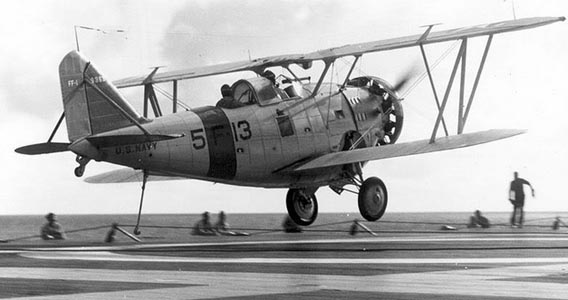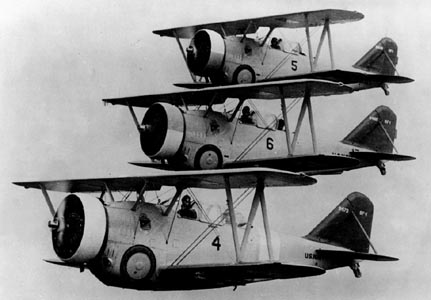FF Fifi
in Action
US Navy
Le FF-1, familièrement appelé Fifi, entra an service en escadron en juin 1933 au sein du Fighter squadron VF-5B basé sur le USS Lexington. La version de reconnaissance, le SF-1 (dont le livraison débuta le 30 mars 1934) entra également en service sur le même porte-avion, mais cette fois-ci au sein du Scout Squadron VS-3B. Les deux versions, furent retirés des escadrons de première ligne de l'US Navy à la fin de 1936 après une assez courte carrière et reversés dans des unités de réserve. Cependant beaucoup étaient encore en service à la fin de 1940. La majorité des FF-1 furent reconvertis en chasseur d'entraînement à double-commande et renommés FF-2 et cantonnés à l'instruction des pilotes.
The FF-1, nicknamed Fifi, entered in squadron service in June 1933 within the Fighter Squadron VF-5B based on the USS Lexington. The reconnaissance version, the SF-1 (whose delivery began March 30, 1934) also entered service on the same aircraft carrier, but this time within the Scout Squadron VS-3B. Both versions were withdrawn from frontline squadrons of the US Navy at the end of 1936 after a relatively short career and versed in reserve units. However many were still in service at the end of 1940. The majority of the FF-1 were converted into dual-control fighter-trainers and renamed FF-2 and confined to pilot training.
 |
 |
FF-1 Fifi décollant du pont d'envol du
USS Lexington. |
Grumman SF-1s de la Naval Air Reserve en 1937. |
FF1 Fifi taking off the
flight deck of the USS Lexington. |
Grumman SF-1s Naval Air
Reserve 1937. |
src: Wikimédia |
Foreign Service
La Canadian Car & Foundry Co produisit également sous licence, une version améliorée du FF-1, le G-23. La firme canadienne en effet assembla 52 appareils, à partir d'éléments usinés aux Etats-Unis. La Royal Canadian Air Force cependant n'accepta pas cet avion dans un premier temps, jugeant celui-ci obsolète et trop lent en cas de conflit. Sur les 52 avions assemblés par le Canada, 34 (GE-23 Delfin) furent acquis par les Républicains espagnols en 1937, sous couvert de financiers turcs, outrepassant l'embargo américains sur les belligérants de la guerre civile espagnole. Le chasseur biplan participa donc au conflit fratricide espagnol, où il fut surclassé par les chasseurs adversaires et y subit de lourdes pertes. Une seule victoire, contre un Heinkel He-59B, fut accordée au chasseur biplan de Grumman durant le conflit. Seulement 11 avions sur les 34, survivent à cette guerre et seront utilisés par la Ejército del Aire Español de Franco.
Canadian Car & Foundry Co also produced under license, an enhanced version of the FF-1, the G-23. The Canadian firm indeed assembled 52 units, from parts machined in the USA. The Royal Canadian Air Force, however, did not accept this aircraft initially, considering it outdated and too slow in case of conflict. Of the 52 aircraft assembled by Canada, 34 (GE-23 Delfin) were acquired by the Spanish Republicans in 1937, under the cover of Turkish financial, overruling the US embargo on the warring parties of the Spanish Civil War. The biplane fighter then participated in Spanish fratricidal conflict, where it was outclassed by opponents fighters and it suffered heavy losses. One kill, against a Heinkel He-59B, was credited to the Grumman fighter biplane during the conflict. Only 11 of the 34 aircraft, survived to this war and will be used by the Ejército del Aire Español of Franco.
Finalement le Canada prendra livraison des 15 derniers avions assemblés par la Canadian Car & Foundry Co, sous le nom de G.23 Goblin. Le Goblin fut utilisé par la RCAF du 17 septembre 1940 jusqu'au 21 avril 1942. Ces avions équipèrent le "Flight A" du 118th RCAF Sqn, basé à Rockcliffe (Ottawa) puis à Dartmouth (Nova Scotia).
Canada finally take delivery of 15 last aircraft assembled by Canadian Car & Foundry Co, as the G.23 Goblin. The Goblin was used by the RCAF from 17 September 1940 until 21 April 1942. These aircraft fitted out the "Flight A" of 118th RCAF Sqn, based at Rockcliffe (Ottawa) and finally Dartmouth (Nova Scotia).
Trois autres exemplaires seront livrés au Nicaragua, au Japon et au Mexique. L'exemplaire japonais avait été acquis pour étudier le train d'atterissage Grumman mais à sa livraison des avions plus modernes étaient déjà entrés en service au sein de l'US Navy.
Three other copies will be delivered to Nicaragua, Japan and Mexico. The Japanese copy was acquired to study the landing gear Grumman but at this delivery, more modern aircraft were already in service with the US Navy.
Sources: